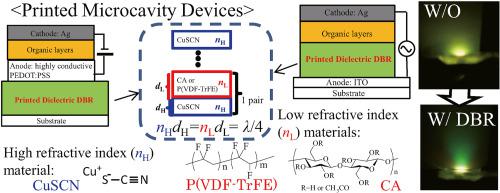Organic Electronics ( IF 2.7 ) Pub Date : 2020-11-06 , DOI: 10.1016/j.orgel.2020.106011 Hirotake Kajii , Masahiko Yoshinaga , Tatsuya Karaki , Masato Morifuji , Masahiko Kondow

|
The concept of using printed inorganic/organic hybrid distributed Bragg reflectors (DBRs) utilizing inorganic semiconductor and insulating polymers in microcavity polymer electroluminescent devices is introduced to provide an approach to achieve the spectral narrowing and the strong forward directionality. The large refractive index contrast of approximately 0.5 (0.44) between inorganic copper(I) thiocyanate, CuSCN, and insulating polymer of poly(vinylidene fluoride-trifluoroethylene), P(VDF-TrFE) (cellulose acetate, CA) results in the fabrication of solution-processed inorganic-organic hybrid dielectric DBRs with high reflectivity (>90%) from nanostructures consisting of only four (five) bilayers. For DBRs composed of CuSCN/CA alternative dielectric layers, all-solution processed microcavity polymer light-emitting diode based on highly conductive poly(ethylenedioxythiophene):poly(styrenesulfonate) anode except for Ag cathode exhibits the narrowing of EL spectrum with a full width at half maximum of approximately 25 nm and the maximum luminance of above 10,000 cd/m2. From the viewpoint of dielectric DBRs based on ferroelectric polymer P(VDF-TrFE) with both low refractivity and high permittivity, we demonstrate a microcavity AC voltage-driven polymer electroluminescent device (μcACEL) which exhibits the spectral narrowing and the strong forward directionality. This work is anticipated to be useful for the development of solution-processed μcACEL with unique device architecture.
中文翻译:

具有利用无机硫氰酸铜(I)和绝缘聚合物进行溶液处理的介电分布式布拉格反射器的微腔聚合物电致发光器件
引入在微腔聚合物电致发光器件中使用利用无机半导体和绝缘聚合物的印刷无机/有机混合分布式布拉格反射器(DBR)的概念,以提供一种实现光谱变窄和强向前方向性的方法。无机硫氰酸铜(I),CuSCN与聚偏二氟乙烯-三氟乙烯(PDF)(VDF-TrFE)(醋酸纤维素,CA)的绝缘聚合物之间的大折射率差异约为0.5(0.44)固溶处理的无机-有机混合电介质DBR具有仅由四个(五个)双层构成的纳米结构,具有高反射率(> 90%)。对于由CuSCN / CA替代介电层组成的DBR,2。从具有低折射率和高介电常数的基于铁电聚合物P(VDF-TrFE)的介电DBR的角度出发,我们展示了一种微腔AC电压驱动聚合物电致发光器件(μcACEL),该器件显示出光谱变窄和强向前方向性。预期这项工作对于开发具有独特器件架构的溶液处理μcACEL很有用。











































 京公网安备 11010802027423号
京公网安备 11010802027423号